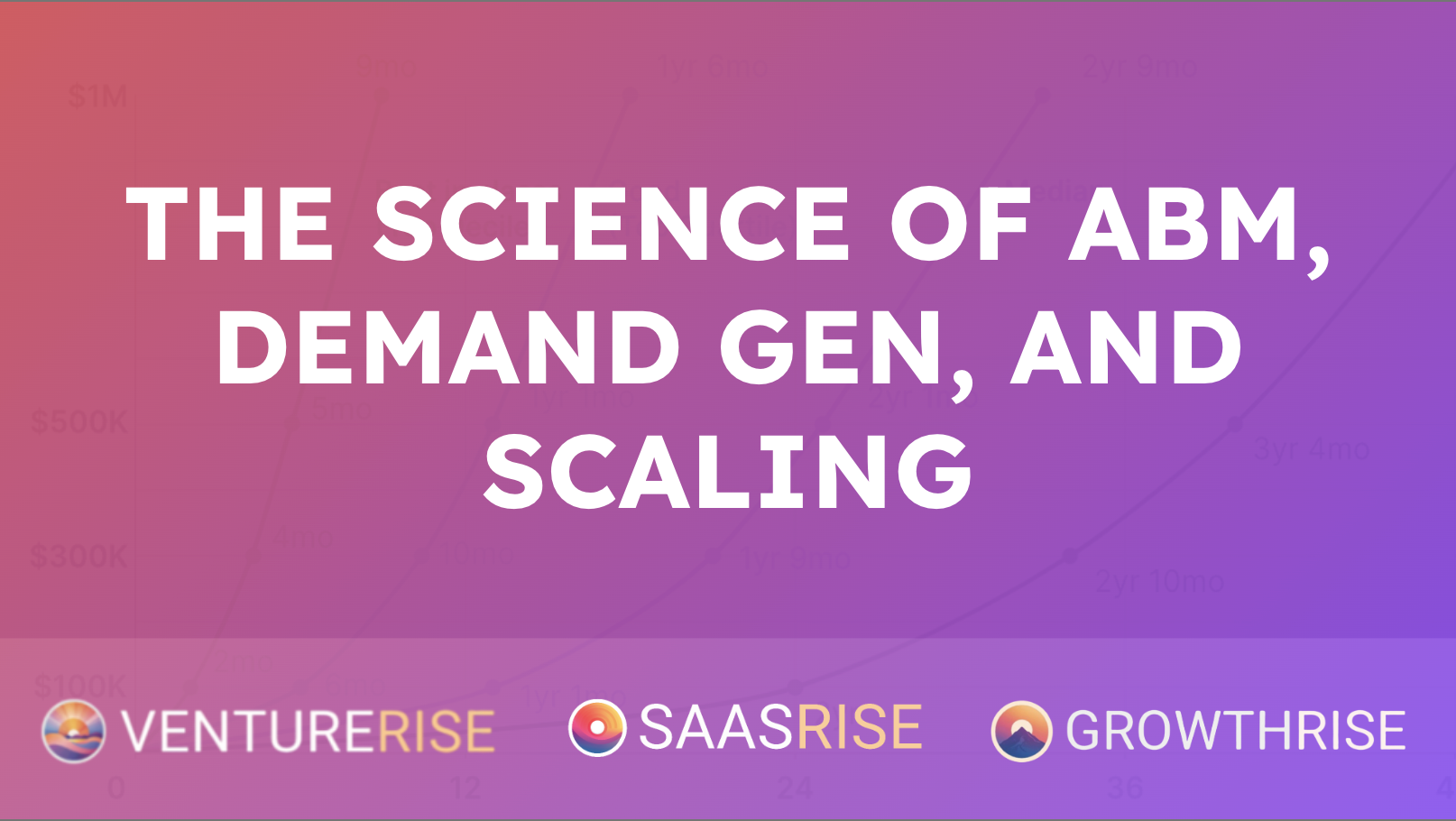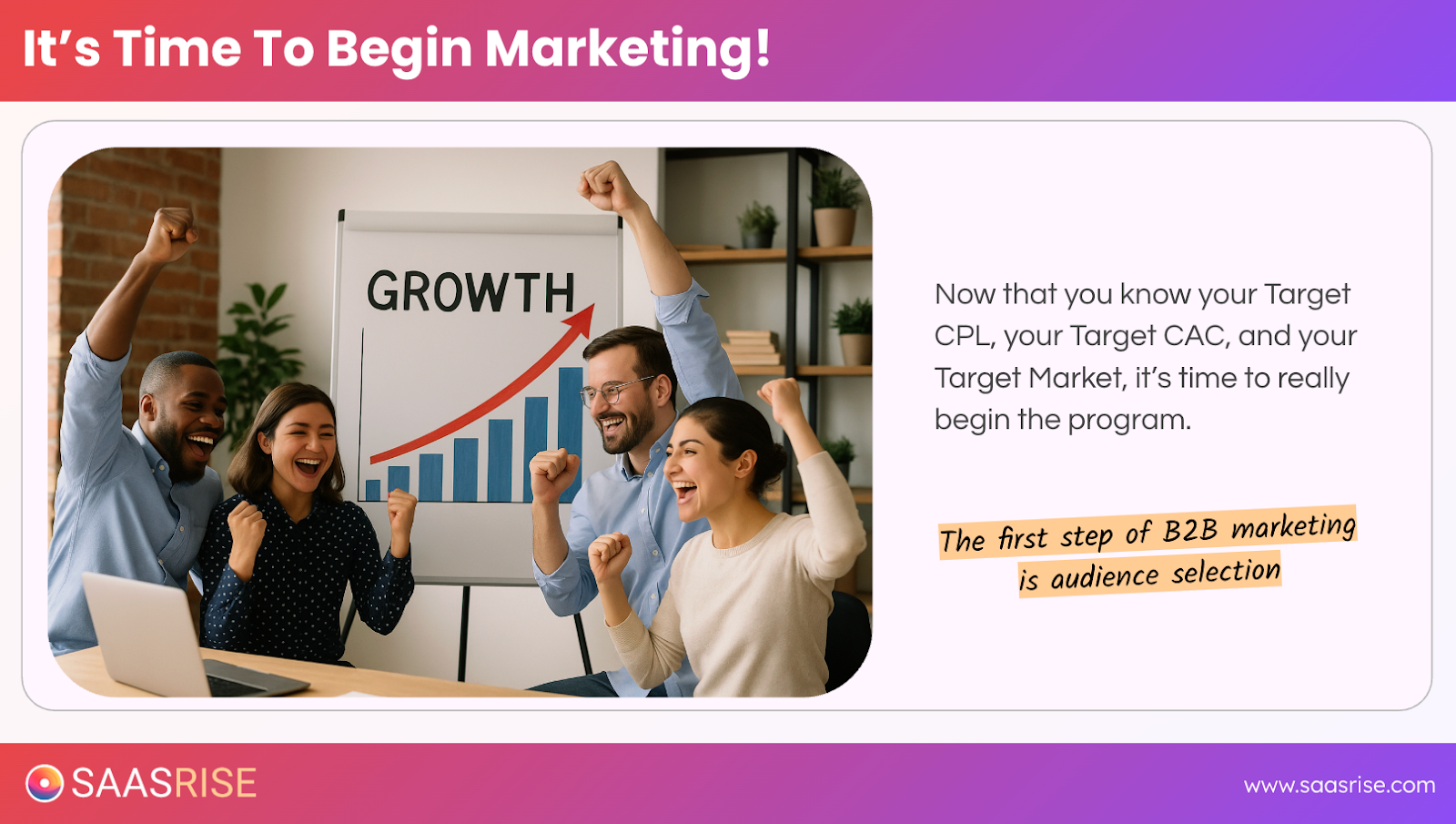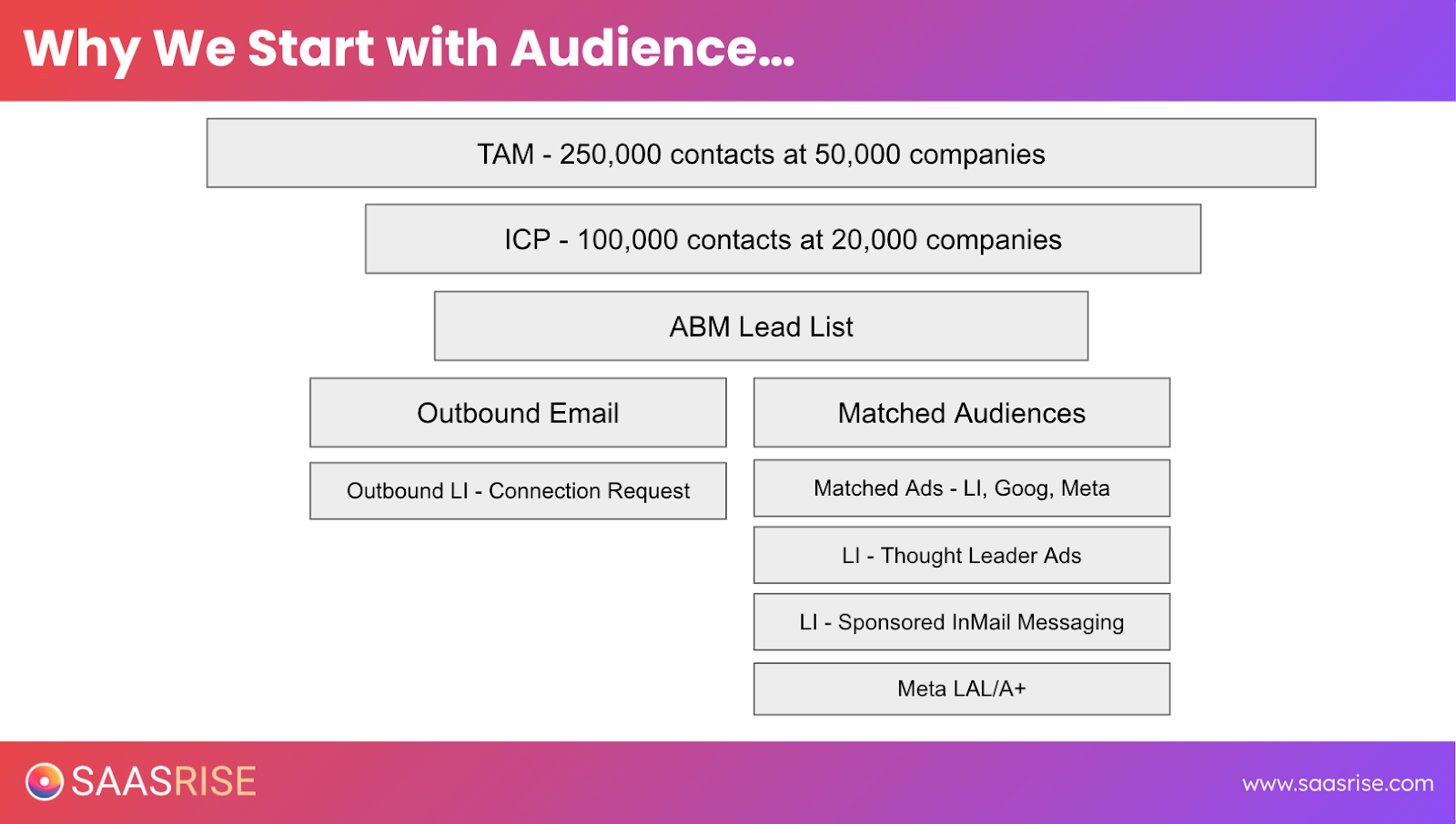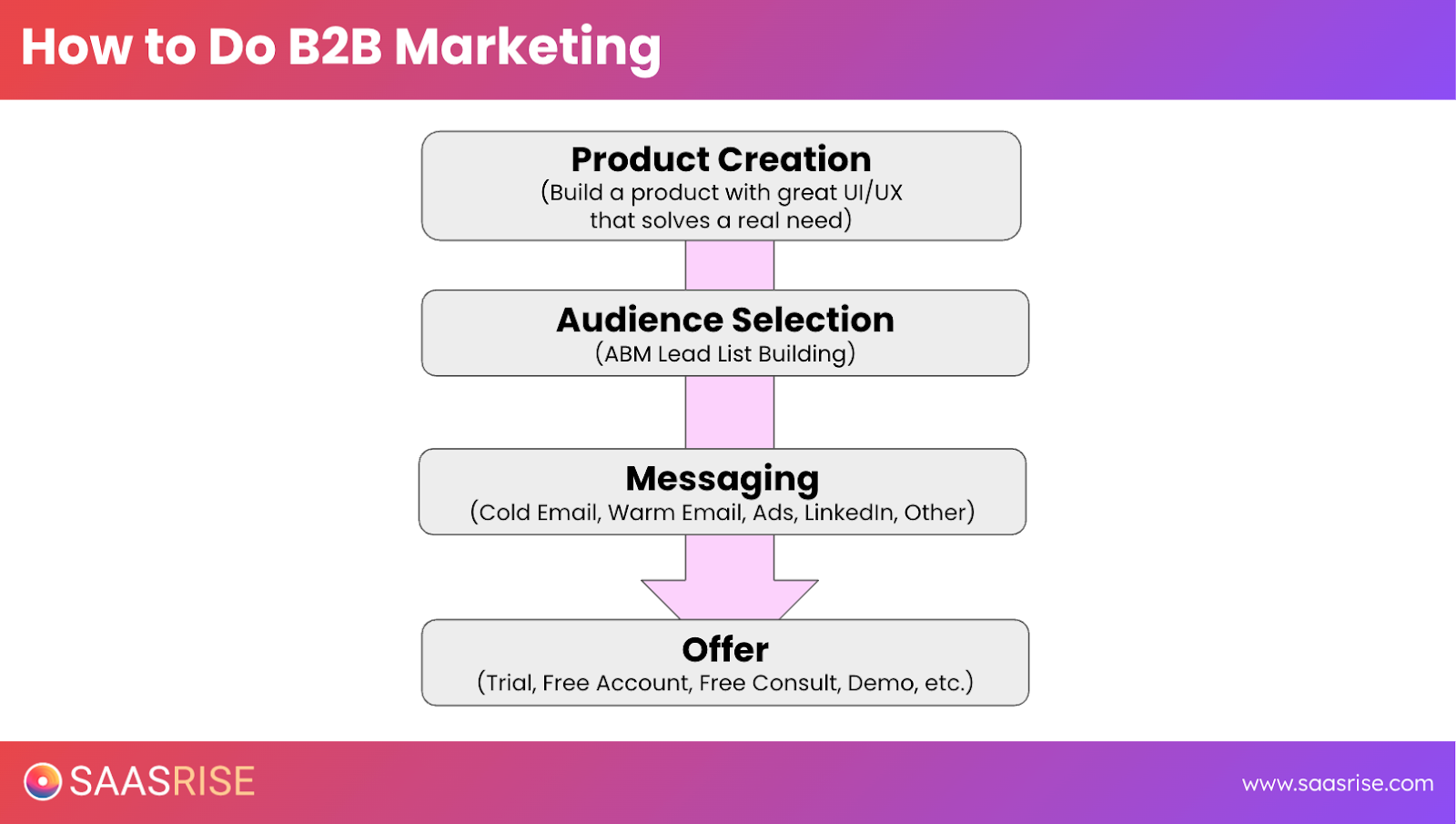
The Science of ABM, Demand Gen, and Scaling
In today’s B2B SaaS world, success isn’t about who shouts the loudest — it’s about who shows up most consistently in the right places. A decade ago, you could spin up a SaaS product, throw a few thousand bucks into Google Ads, and watch demos roll in. Those days are gone. The market’s noisier. Every niche has 30 vendors saying the same thing.
So what separates the SaaS companies that break through from the ones that plateau? It’s not luck or “growth hacks.” It’s precision.
The companies that scale predictably are the ones building systems — engines that run on alignment and data, not hope.
At the core of that engine are three moving parts:
- ABM (Account-Based Marketing): knowing exactly who to target.
- Demand Generation: making those people aware of you.
- Demand Capture: converting them when they’re ready to buy.
That’s the system behind predictable SaaS growth — the science that takes you from $1M ARR to $10M ARR and beyond. Let’s break it down step by step.
Step One: Nail Your Economics Before You Scale
Before you do anything else — before you build a list, launch a campaign, or hire an SDR — you’ve got to understand your economics.
Too many founders try to grow without knowing whether their marketing spend is actually sustainable. But once you know your numbers, you gain something rare: clarity and confidence.
Here’s how I think about the math that matters:
- Customer Acquisition Cost (CAC): How much it costs you to acquire one new paying customer. Ideally, this should be about one-sixth of your customer’s lifetime value (LTV).
- Lifetime Value (LTV): What a customer is worth to you over their entire relationship — calculated as average revenue per account × gross margin × average customer lifespan.
- Payback Period: How quickly you earn back your CAC. For bootstrapped SaaS, you want this under nine months.
- Churn Rate: How many customers you lose each month. Keep it below 3%.
- LTV:CAC Ratio: The ratio that shows how much value you get back per dollar spent acquiring. A healthy SaaS business lives in the 6–8:1 range.
Let’s put that into perspective.
Say your average customer pays $1,700 per month, churns at 2.4% monthly, and stays about 63 months. That’s roughly $155,000 in lifetime value. Divide that by six and your target CAC should be around $25,000.
If your sales team closes one in nine qualified leads, that means you can afford a cost per lead (CPL) of around $2,000.
Those are your guardrails. They define your sandbox. They tell you how much you can safely invest in data, ads, and content — and still stay profitable.
Once you know those numbers, you stop guessing and start playing offense.

Step Two: The Journey From Strangers to Evangelists
Every SaaS business follows the same invisible path — even if you’ve never mapped it out. It goes something like this:
Strangers → Visitors → Leads → Demos → Customers → Evangelists
Your job isn’t to push people down that path. It’s to design systems that guide them through it naturally.
At the very top of that journey are strangers — people who’ve never heard of you but fit your ideal customer profile (ICP). That’s where demand generation comes in: you’re building awareness and trust long before the first click or search.
Once they know who you are, demand capture steps in — through ads, landing pages, retargeting, and outreach.
Then, if you deliver a great product experience and a smooth onboarding, you turn those customers into evangelists — people who sell for you by word of mouth.
That’s the modern SaaS flywheel. It’s not linear. It’s compounding.
Step Three: ABM — The Foundation of Everything
Every successful SaaS growth engine starts with one thing: data precision.
Account-Based Marketing (ABM) isn’t just for enterprise. It’s not about having a huge team or fancy tech. It’s about knowing exactly who to go after — and tailoring your marketing to speak only to them.
When you do ABM right, you’re not shouting into the void. You’re whispering directly to the 100,000 or 200,000 people in the world who could actually buy from you.
Let’s clarify two key concepts:
- TAM (Total Addressable Market): Everyone who could buy your product.
- ICP (Ideal Customer Profile): The subset of people who are most likely to buy, pay more, and stay longer.
For example, if your TAM is 250,000 contacts across 50,000 companies, your ICP might be closer to 100,000 contacts across 20,000 companies — and within each of those, 3–10 key decision-makers you need to reach.
When you know exactly who your target accounts are, everything gets easier:
- Your ads become more relevant.
- Your outreach becomes more personal.
- Your reporting becomes more accurate.
ABM gives you focus — and focus is what drives efficiency.
Step Four: Building Your ABM Lead List
The quality of your list determines the quality of your results. Period.
When we built SaasRise, we didn’t start with ads. We started with a list — 450,000 SaaS CEOs and founders across 14 platforms. That dataset became the fuel for everything else we did.

Here’s how you can do the same.
Start with these tools:
- Apollo.io — the workhorse of B2B data. Affordable, accurate, and great for SaaS targeting.
- Instantly.ai — combines list building, cold email, and AI-powered personalization. Ideal for launching outbound fast.
- ListKit.io — lightweight, intuitive, and useful for quick segmentation and testing.
Start with Apollo for the core dataset, use Instantly for personalized outreach, and ListKit to experiment with new segments.

If you’re scaling fast, a data broker can save you serious time and money. We work with one who can pull verified Apollo data for 80–85% less cost. You send over your search parameters, and within 48 hours, you’ve got a verified, ready-to-go list.
Once you have your list, enrich and clean it.
Combine multiple datasets, remove duplicates, and append fields like:
- Personal emails (to improve ad match rates)
- Phone numbers (for higher-ACV deals)
- LinkedIn URLs (for personalized outreach)
Clean data isn’t optional — it’s the difference between wasting money and scaling profitably.
For most SaaS businesses, here’s the ballpark:
- Mid-market (ACV ~$20K): 50K–150K contacts.
- Enterprise (ACV ~$200K): 10K–25K highly targeted contacts.
Enough to generate statistical results — but not so broad that your message gets diluted.
Step Five: From Lists to Demand Generation
Now comes the fun part — turning your dataset into awareness.
Demand Generation is how you make your ICP aware of you before they’re searching.
This is where many SaaS founders miss the mark. They spend their entire budget on Google Search — chasing buyers already in-market — and then wonder why they can’t scale.
Demand Gen is how you feed your future pipeline.

Here are the core tactics I recommend:
- Matched Audience Ads: Upload your ABM list to LinkedIn, Meta, and Google. Run awareness ads directly to those contacts.
- Thought Leadership Content: Publish weekly podcasts, webinars, or posts. Then boost them to your ICP using those same matched audiences.
- Outbound Marketing: Send personalized sequences through Instantly. Follow up on opens with connection requests or DMs.
- Lookalike Audiences: Let AI expand your reach to new people who “look like” your ICP.
Your goal is what I call The Omnipresence Principle: your target audience should see your brand at least ten times a month.
If your ICP is 100,000 people, that’s a million impressions monthly — roughly $50K in ad spend. That’s the level of consistency required to build mental availability and trust in modern B2B SaaS.
Step Six: Demand Capture — Converting Awareness Into Revenue
If Demand Gen builds the runway, Demand Capture is the jet that takes off.
This is where you turn awareness into pipeline.
The main channels that do this are:
- Paid Search: Bidding on brand and competitor keywords on Google and Bing.
- Review Sites: Sponsored placements and intent data from G2, Capterra, etc.
- Retargeting: Following up with everyone who clicked your ads or visited your site.
- Conversion Tools: On-site chat, demo pop-ups, and trial offers that convert traffic into action.
But here’s a trap I see founders fall into: they think their Demand Capture channels are cheaper just because Google Ads show a lower CAC.
In reality, capture looks efficient only because Demand Gen already did the heavy lifting — it built awareness and primed intent.
Without a steady flow of Demand Gen traffic, your capture campaigns plateau fast.
That’s why the best SaaS companies split their budget roughly 50/50 between the two. Half on creating demand, half on capturing it.
That’s how you build both brand equity and pipeline velocity.
Step Seven: Integration — Making the Engines Work Together
The secret to predictable SaaS growth isn’t any single channel. It’s how you connect them.
You need a tight feedback loop that keeps all three components — ABM, Demand Gen, and Demand Capture — in sync.
Here’s how that loop flows:
- Demand Gen fuels Demand Capture. The more awareness you build, the better your search and retargeting perform.
- Demand Capture fuels Demand Gen. Every customer you close creates stories, testimonials, and case studies to share.
- Sales feeds Marketing. Closed-won data sharpens your ICP and targeting for the next cycle.
It’s a continuous flywheel — a living system that improves with every rotation.
A simple workflow looks like this:
- Build your ABM list (say, 100K ICP contacts).
- Upload to LinkedIn, Meta, and Google.
- Run brand awareness ads.
- Retarget clicks and searches.
- Launch outbound email sequences.
- SDRs follow up with replies and demo requests.
- Feed closed-won insights back into your data.
That’s the modern SaaS growth loop. Once it’s humming, it compounds.
Step Eight: Scaling Through Data and Automation
Data used to be expensive. Now it’s a superpower.
Fifteen years ago, building a 100K-person B2B list might’ve cost $25K. Today? You can do it for under $1K with the right brokers and APIs.
Here’s what’s changed:
- APIs and Data Brokers can pull millions of verified records in hours.
- AI Tools like Clay and ChatGPT can enrich, qualify, and segment automatically.
- Modern Email Verification gives you 95%+ deliverability rates.
When you treat data as an asset — not an expense — your ROI multiplies.
Here’s a quick example:
You invest $5K in high-quality data. That gets you 100K verified contacts. Let’s say half match to ad platforms — now you’re showing ads to 50K real prospects.
With a 1% click-through rate, that’s 500 visitors. If 10% of those convert to demos, that’s 50 demos.
If 20% of those demos close at $20K ACV, that’s $200K in new ARR.
That’s a 40x return — and it starts with smart data.
Step Nine: The Team and Tools You Need
As you grow, you’ll need people to manage this system — not necessarily a big team, but the right team.
You’ll want:
- A Marketing Ops Lead to manage your data, tools, and integrations.
- A Growth Marketer to run your ads and manage your ABM audiences.
- An Outbound Manager to oversee Instantly campaigns.
- Inbound SDRs to qualify inbound leads and book demos.
- AEs (Account Executives) to close deals.
And for tools, I’d recommend:
- HubSpot or Pipedrive for CRM.
- Clay for enrichment and automation.
- Instantly for outbound.
- Zapier or Make for workflow automation.
Scaling isn’t about adding headcount — it’s about adding precision.
Step Ten: Metrics That Matter
When you combine ABM, Demand Gen, and Capture, you’ll want dashboards that show the full picture.
For your ABM and data layer, track verified contacts, match rates, and enrichment coverage. Aim for at least 70–80% match accuracy.
For Demand Gen, look at impressions, reach, and engagement. A good goal is 10 exposures per ICP contact each month.
For Demand Capture, focus on CPL, CAC, and conversion rates. Keep CAC below one-sixth of your LTV.
And at the full-funnel level, monitor pipeline growth and payback period. If you can recover CAC in under nine months, you’re in the sweet spot.
Great SaaS marketing teams don’t just “spend budgets.” They operate like portfolio managers — reallocating budget to where ROI compounds fastest.
Step Eleven: Lessons From the Field
After working with over 75 SaaS companies on this model, here are a few lessons that stick:
- List quality is everything. Bad data kills ROI.
- Patience wins. Demand Gen compounds over quarters, not weeks.
- Don’t obsess over perfect attribution. Get it roughly right, not perfectly wrong.
- ABM isn’t just for enterprise. If your ACV is over $2K, ABM principles apply.
- Own your data. Don’t rely on agencies or rented audiences — your list is an appreciating asset.
Step Twelve: The Mindset of a Systems Builder
At its core, scaling a SaaS company isn’t about doing “more.” It’s about doing the right things systematically.
When you have:
- A clean, verified ICP dataset,
- Consistent matched audience ads running,
- Active outbound sequences, and
- A feedback loop connecting Demand Gen and Capture…
You stop guessing. You start engineering.
Marketing stops feeling chaotic. It starts feeling like math.
Step Thirteen: The Playbook in One Sentence
ABM defines who you target.
Demand Gen makes them aware.
Demand Capture closes the deal.
Put all three together, and you’ve got a predictable, scalable SaaS growth engine.
Final Thoughts — The Science of Scale
When you understand how these pieces fit together, you realize growth isn’t magic — it’s math and momentum.
It’s not about viral posts or lucky breaks. It’s about building a repeatable system that turns strangers into customers inside your payback window.
That’s the science of ABM.
That’s the art of Demand Generation.
That’s the discipline of Demand Capture.
So here’s what I’d do in the next two weeks:
- Define your ICP and TAM.
- Build your ABM list with Apollo, Instantly, and Clay.
- Enrich and clean your data.
- Launch matched audience ads.
- Run outbound sequences.
- Track your metrics.
- Iterate weekly.
Do that consistently for 90 days, and you’ll have the foundation for a scalable, predictable SaaS business that can double, triple, or even 10× over time.
Because scaling isn’t about doing everything — it’s about doing the right things systematically, scientifically, and repeatedly.
Now go build your engine.
— Ryan Allis, CEO, SaasRise

